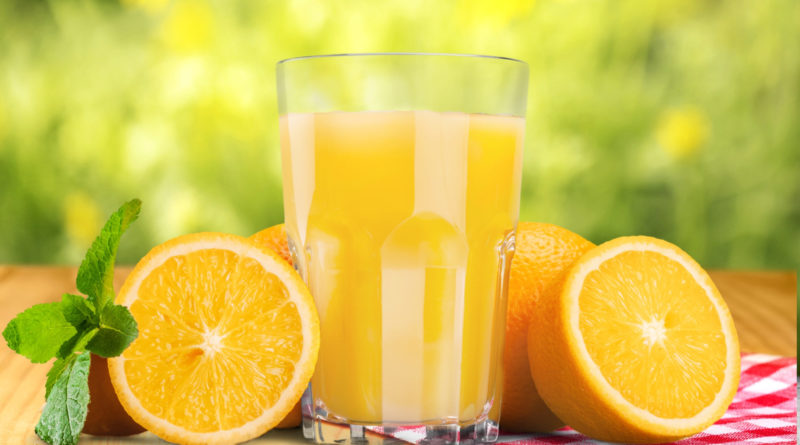The Problem with Fruit Juice: All That Sugar
I’ve always had a bee in my bonnet about fruit juice. The overabundance of sugar in our diet has given rise to Richter-scale antipathy to soda, but fruit juice, which often has even more sugar in it, gets a pass just because it has “fruit” in the name.
This is playing out in places that have enacted soda taxes, which do reduce soda purchases. But there’s evidence that some consumers avoid those taxes by switching to non-taxed but still sugar-laden drinks. Like fruit juice. Is it any better than soda, really?
I will concede that, because it really is made from fruit (and I’m talking about 100 percent fruit juice here), it also has some nutrition. The question is whether the upside of nutrients outweighs the downside of the sugar, or whether fruit juice really is the health con I’ve always thought it was.
Let’s take the downside first. Fruit juice has a whole lot of that sugar: 8 ounces of Apple & Eve apple juice has 110 calories (including 26 grams, or more than 6 teaspoons, of sugar — I just find calories the most intuitive way to compare); Welch’s grape juice has 140 calories; Tropicana orange juice has 112; Pom Wonderful pomegranate juice has 160. For comparison, Coca-Cola has 96).
5 truths about dieting everyone can — or should — agree on
I don’t think sugar is poison, and I don’t think it’s uniquely fattening. While some scientists think it contributes to disease risk (independent of its contribution to weight gain), I don’t find the evidence for that to be particularly persuasive. I do think it makes a lot of foods taste good, which explains why it’s in so many processed foods and Americans eat so much of it. It makes food and drink go down easy, and there’s little question that it has contributed to our overeating.
It’s worth noting, though, that our sugar consumption has been decreasing for a good 20 years now. According to the U.S. Agriculture Department, it dropped 19 percent between 1999 and 2019 (that’s before the pandemic had us retreating into comfort foods) — although it’s still a beefy 344 calories per day. In about the same time period, obesity among American adults went from 30.5 percent to 42.4 percent, so it’s clear sugar isn’t the sole culprit, but everyone agrees we ought to be eating less of it.
Here’s what gets me about fruit juice. It has so much sugar that you can take the water out of it and use it like other sweeteners. On ingredient lists it’s called “juice concentrate,” and the Food and Drug Administration requires that it be counted as an “added sugar” on the nutrition facts panel. Unless, of course, you just add it to water, in which case it’s just fruit juice, and the label can say “no added sugar.”
Why ‘moderation’ is the worst weight-loss advice ever
That’s the downside. But then there’s the nutrition, particularly a group of compounds called polyphenols. Do they confer any benefits? Enough to justify all that sugar?
There are two ways to figure this out. The first is to look at population studies that compare people who drink juice to people who don’t. If you come here often, you know exactly what I think of those studies: They’re too inaccurate (people can’t report their intake accurately) and too confounded (people who drink juice are different from people who don’t in all kinds of ways) to be able to tease out any effects from the nutrients in fruit juice.
If you don’t believe me, here’s Fruit Juice Exhibit A in my one-woman crusade to stop using this kind of research to make dietary recommendations. It followed 187,382 people in three cohorts, for nearly 3.5 million person-years. Holy moly, that’s a lot! And it found that juice-drinking was associated with an 8 percent increase in the risk for diabetes.
But you know what else it found? Cantaloupe was associated with a 10 percent increase of diabetes risk, and strawberries with a 3 percent increase. Grapes, though, were a 12 percent decrease. Nobody, and maybe even literally nobody, would tell you to trade in your cantaloupe for grapes. And if you can’t believe it on cantaloupes, you can’t believe it on fruit juice either. There’s a reason statisticians call studies like this “noise mining.”
Energy density is your grandmother’s diet, and it still works
You’ve got a better shot with the second way: a controlled trial. Give some people juice and some other people juice-colored sugar water, and see if there are any meaningful differences. There are plenty of studies, mostly funded by juice makers, that attempt to show a health impact. If, some day, you find yourself with time on your hands, I invite you to hop on over to PubMed and peruse the fruit juice controlled-trial literature.
You’ll find individual studies showing that juice (pomegranate juice, for example) slows absorption of carbohydrates, but a meta-analysis of studies shows no results. In one study, researchers doctored juice with either extra amounts of the polyphenol (hesperidin) thought to be responsible for slowing glucose absorption, or extra water. The water slowed absorption but the polyphenol didn’t. Go figure.
You’ll also run across a study that found that juice was “DNA-protective,” but wait! The placebo was, too. Another found that two 8-ounce servings of tart cherry juice (280 calories) improved sleep by some measures but not by others. Alas, it didn’t help the performance of “well-trained water polo players.”
I could go on, but I won’t. If you do, you’ll undoubtedly find a study here and there that shows a benefit, but it’s hard to make the case that, overall, there’s an advantage to drinking fruit juice.
But I never know what I might be missing, so I called one of the best-known nutrition experts going: Marion Nestle, professor emerita at New York University.
“Is fruit juice okay?” I asked.
“Sure,” she said.
Sure? After I’ve had that bee in my bonnet all these years, Marion Nestle says, “Sure”?
So I asked her whether it was because the polyphenols reduced disease risk.
Readers, she laughed. Out loud. And then she explained.
“If we can agree about anything about diet, and I’m not sure we can, almost everyone agrees that diets that have fruits and vegetables in them are healthy. The specific reasons aren’t known. . . . And the basic principle is to vary them. If you mix them, you’re going to pick up all the ones you need.”
This was starting to sound familiar to me. Where had I heard that before? Oh yeah! I say it myself, all the time. We don’t have the tools to suss out specific benefits from fruit juice or anything else, so our best bet is a variety of whole-ish foods — and fruit juice is one of them. Not as whole as fruit, and missing the fiber and nutrients in what juicing leaves behind, but still.
It’s really annoying when someone you respect uses the exact argument you make all the time to disabuse you of your take on, say, fruit juice. The words “hoist” and “petard” come to mind.
Maybe I’ve been a little hard on fruit juice.
The key, says Nestle, is “little tiny glasses.” Specifically, 4- to 6-ounce glasses, which are usually about the equivalent of one piece of fruit. “There’s a reason they’re called ‘juice glasses,’ ” she says.
The problem with fruit juice is the ease with which we can down several fruits’ worth of sugar — all of the calories with only part of the nutrition. We’re all very attuned to health messages that allow us to eat the foods we enjoy, and attributing special nutritional powers to juice can be a license to overindulge.
I’m prone to overindulgence, so I avoid fruit juice, with one exception: the fermented kind (and I’m careful not to overindulge there). If you’re wondering whether wine is good for you, there’s lots of conflicting evidence about that, too, and it’s a column for another day. Meantime, those of you who are capable of Nestlean moderation should drink 4 to 6 ounces without worrying that it’s a con.
Source: https://www.washingtonpost.com/food/2021/11/22/fruit-juice-nutrition/

